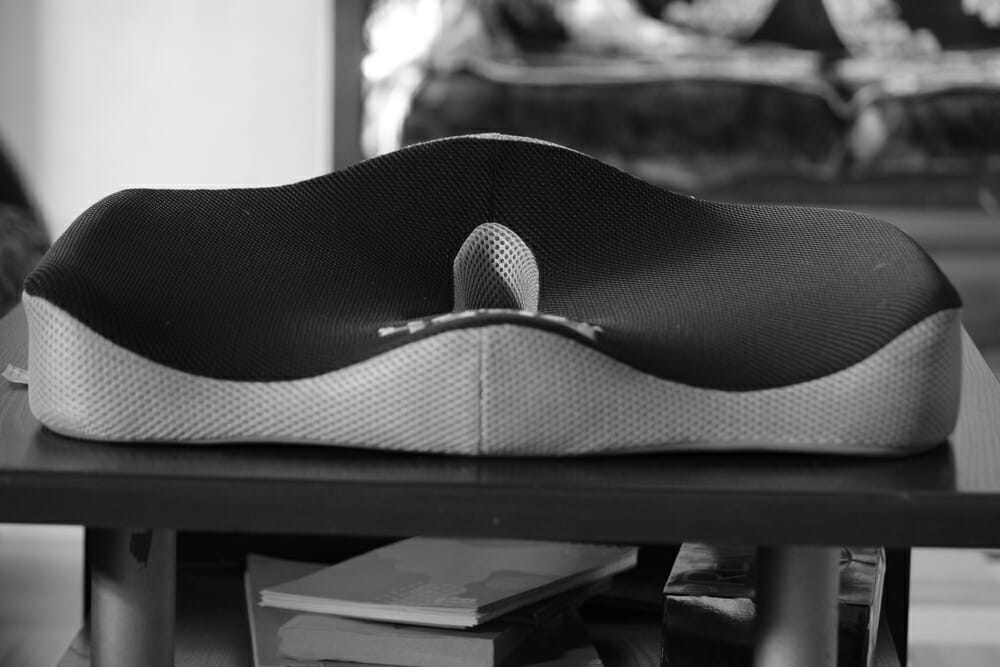
Have you ever had tailbone pain that just won’t quit?
If you’re wondering how to sit with coccyx pain without causing more pain you’re in good company.
Coccyx pain, known medically as coccydynia, is a real frustration for many, turning daily activities into a torturous exercise.
Whether it’s a result of a past injury, prolonged sitting on unforgiving surfaces, or even more serious causes like infections or degenerative changes, one thing is clear – understanding the root cause is the key to finding relief.
We’re here to help you sit comfortably and manage that nagging coccyx pain.
What is the coccyx?
The coccyx, also known as the tailbone, is a small triangular bone at the base of the spine.
It can be a source of pain and discomfort, known as coccyx pain or coccydynia.
This pain can range from a dull ache to sharp, localised discomfort, making sitting, standing, and walking challenging.
Common causes of coccyx pain
Coccyx pain doesn’t just happen out of the blue, but it can originate from a wide range of causes. Understanding the root cause of your pain is the first step towards effective management.
- Tailbone injury or trauma: A fall or direct blow to the tailbone can result in coccyx pain. This can occur due to accidents, sports-related injuries, or even slips and falls.
- Prolonged Sitting on Hard Surfaces: Sitting on hard surfaces for extended periods, such as wooden or metal chairs, can put pressure on the coccyx and lead to pain and discomfort.
- Childbirth: Women who have recently given birth may experience coccyx pain due to the pressure exerted on the tailbone during labour and delivery. A lot of pelvic floor muscles are connected to the tailbone, so it makes sense!
- Repetitive Strain: Activities that involve repetitive movements or strain on the tailbone, such as cycling or horseback riding, can contribute to coccyx pain over time.
- Infections or Abscesses: In rare cases, infections or abscesses in the area around the coccyx can cause pain and inflammation.
- Degenerative Joint Changes: Over time, the joints and discs in the coccyx region can undergo degenerative changes, similar to other joints in the body. This can lead to pain and stiffness in the tailbone area.
- Tumors or Growths: Though rare, tumors or abnormal growths near the coccyx can cause coccyx pain.
- Poor Posture: Sitting with poor posture, such as slouching or hunching forward, can put additional stress on the coccyx and lead to discomfort.
- Fracture or Injury to the Coccyx: A fracture or injury to the coccyx, usually from a significant impact or trauma, can result in severe coccyx pain.
- Congenital Abnormalities: Some individuals may be born with structural abnormalities in the coccyx, such as a misshapen or overly flexible tailbone, which can contribute to chronic coccyx pain.
How to sit comfortably with coccyx pain
Choose the right chair
Opt for a chair that provides adequate support and cushioning for your tailbone – especially when it comes to your office chair.
Look for chairs with padded seats or consider using a chair with an ergonomic design that promotes proper posture.
Maintain a proper sitting position
Sit with your back straight, shoulders relaxed, and feet planted firmly on the ground. Avoid slouching or leaning forward, as this can put additional strain on your tailbone.
Use a coccyx wedge or coccyx cushion
Use a coccyx cushion or wedge-shaped cushion specifically designed to relieve pressure on the tailbone. These cushions provide extra padding and support, helping to distribute weight evenly and reduce discomfort.

Create a comfortable sitting space
If you’re sitting on a hard surface, such as a wooden chair, place a cushion or a folded towel underneath you to provide additional cushioning and reduce direct pressure on the tailbone.
Take regular breaks and change positions
Remember, even with the best chair in the world, your body needs regular breaks from being in a seated position for a long time.
Avoid sitting for prolonged periods without breaks. Stand up, stretch, and walk around every 30 minutes or so to relieve pressure on the tailbone.
Changing positions frequently helps prevent stiffness and discomfort.
Use good body mechanics
When sitting down, try to avoid sudden or forceful movements that may jar or impact the tailbone. Instead, lower yourself down gently, supporting your weight with your legs rather than relying solely on your tailbone.
Apply heat or cold therapy
For temporary relief from coccyx pain, apply a heat pack or cold pack to the affected area. Heat therapy can help relax muscles and increase blood flow, while cold therapy can reduce inflammation and numb the area.
Think soothing hot baths or an ice pack strategically placed at the pain epicentre.
Stretch and exercise
Engage in gentle stretching and strengthening exercises targeted at the muscles around the tailbone and lower back. Consult with a healthcare professional or physiotherapist for specific exercises suitable for your condition.
Remember, ‘no pain, no gain’ doesn’t apply here; take it easy and never push into pain.
Get some pain relief
Over-the-counter pain relief relievers can also be handy for immediate relief, but use them sparingly and always consult your healthcare provider before starting any new medication.
Preventing coccyx pain
Prevention, as they say, is better than treatment. Look at doing the following to prevent coccyx pain.
- Choose seating wisely: Opt for seats that distribute your weight evenly and provide sufficient cushioning to avoid excessive pressure on the tailbone. Avoid hard, unforgiving surfaces for prolonged sitting.
- Maintain an active lifestyle: Engage in regular exercise to keep your muscles strong and your joints flexible. This helps support proper posture and reduces the risk of developing coccyx pain.
- Follow a balanced diet: A nutritious diet supports overall health, including the health of your bones and joints. Ensure you’re getting the necessary nutrients for optimal well-being.
Sometimes you need a bit of extra help
If your coccyx pain persists despite your best efforts, or if you’re experiencing severe pain, don’t try to tough it out alone. Reach out to a professional physio for coccyx pain for help.
At Integrity Physio, we bring a wealth of knowledge and experience in managing coccyx pain.
Whether it’s hands-on manual therapy or customised exercises, our qualified and empathetic physiotherapists are equipped to guide you on your path to recovery.
And we’re not just about fixing your current issues – we’re also here to equip you with the knowledge and strategies to prevent future occurrences of coccyx pain.
Visit Integrity Physio in South Perth – book an appointment today.

